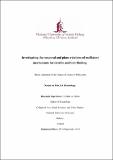| dc.contributor.advisor | Elliott, Mark A. | |
| dc.contributor.author | du Bois, Naomi | |
| dc.date.accessioned | 2019-02-11T15:13:01Z | |
| dc.date.available | 2019-02-11T15:13:01Z | |
| dc.date.issued | 2019-02-11 | |
| dc.identifier.uri | http://hdl.handle.net/10379/14941 | |
| dc.description.abstract | Abstract
Introduction: Auditory binding refers to the integration of the components of a sound to form a wholistic percept. The present research explores similarities within visual and auditory binding mechanisms by testing two theories grounded in visual binding research: The General Phase Angle Hypothesis (GPAH), and the Return Phase Hypothesis (RPH). Informed by the findings, differences in the structure of the auditory binding mechanism dependent on music training were examined using a combination of experimental and neuroimaging techniques. The findings contribute to our knowledge of anticipatory coding as a dynamic system, necessary to navigate within a dynamic environment.
Methods. All experiments employed an auditory priming/stimulus entrainment paradigm to evoke an auditory gamma-band response (aGBR) that is phase locked to the frequency of the primed target stimulus. Trials required a forced choice reaction time (RT) response, thus providing a psychophysical measure of the internal oscillatory mechanism involved in auditory cognition. The third study incorporated Magnetoencephalography (MEG) neuroimaging.
Results. The GPAH proved a better predictor of an anticipatory effect, beyond an effect of priming – emphasised by the findings from a study guided by a capacity sharing relation derived from the Time Quantum Model (TQM). Regarding the second phase, musicians and non-musicians demonstrated differential priming effects.
Conclusions. The TQM capacity sharing relation provides a template for the optimal experiment-stimulus parameters with which to investigate the phase interactions within the auditory oscillatory mechanisms required for binding. While priming enhances early bottom-up (gamma) carrier frequencies, the process also shifts critical gamma frequencies involved in auditory binding mechanisms by ~2 Hz, considered to be due to delta superimposition resulting from task demands. Furthermore, musicians demonstrate a reduced effect of priming. The implication is this population rely more on top-down processes as training strengthens the corticofugal system, allowing for more efficient feedback from higher auditory processing areas. | en_IE |
| dc.publisher | NUI Galway | |
| dc.rights | Attribution-NonCommercial-NoDerivs 3.0 Ireland | |
| dc.rights.uri | https://creativecommons.org/licenses/by-nc-nd/3.0/ie/ | |
| dc.subject | Entrainment | en_IE |
| dc.subject | Oscillatory mechanism | en_IE |
| dc.subject | Auditory priming | en_IE |
| dc.subject | Magnetoencephalography | en_IE |
| dc.subject | Auditory masking | en_IE |
| dc.subject | Psychology | en_IE |
| dc.title | Investigating the temporal and phase relations of oscillatory mechanisms involved in auditory binding | en_IE |
| dc.type | Thesis | en |
| dc.contributor.funder | Irish Research Council | en_IE |
| dc.local.note | This thesis is grounded in basic research around auditory and music cognition. The aim was to investigate the effect of specific cortical gamma-theta phase relationships on auditory binding – the integration of separate neural systems coding the components of a distinct sound, and whether, or how, music training facilitates this process. | en_IE |
| dc.local.final | Yes | en_IE |
| nui.item.downloads | 804 | |


